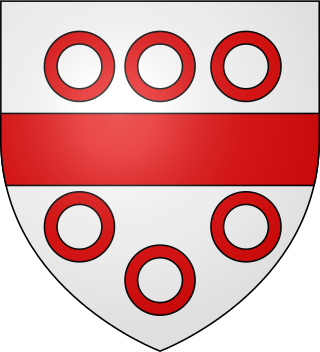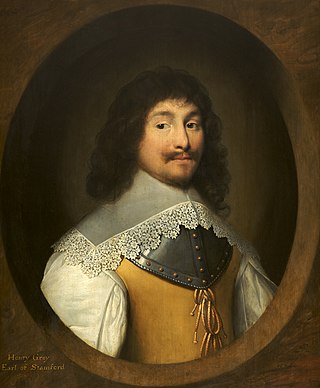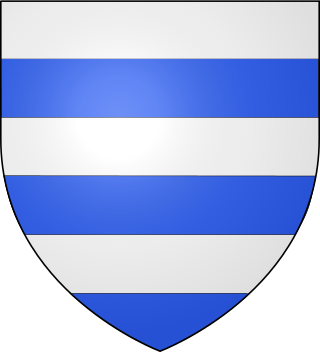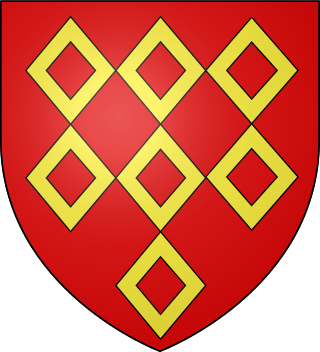Thomas Grey, 1st Marquess of Dorset, 1st Earl of Huntingdon, 7th Baron Ferrers of Groby, was an English nobleman, courtier and the eldest son of Elizabeth Woodville and her first husband Sir John Grey of Groby. Her second marriage to King Edward IV made her Queen of England, thus elevating Grey's status at court and in the realm as the stepson of the King. Through his mother's endeavours, he made two materially advantageous marriages to wealthy heiresses, the King's niece Anne Holland and the King’s cousin, Cecily Bonville, 7th Baroness Harington. By the latter, he had 14 children.

Duke of Suffolk was a title that has been created three times in the peerage of England.

Baron Hastings is a title that has been created three times. The first creation was in the Peerage of England in 1290, and is extant. The second creation was in the Peerage of England in 1299, and became extinct on the death of the first holder in c. 1314. The third creation was in the Peerage of England in 1461, and has been in abeyance since 1960.
The title of Baron Grey of Codnor is a title in the peerage of England.

Baron Lucas is a title that has been created twice in the Peerage of England. The second creation is extant and is currently held with the title Lord Dingwall in the Peerage of Scotland.

Baron Stafford, referring to the town of Stafford, is a title that has been created several times in the Peerage of England. In the 14th century, the barons of the first creation were made earls. Those of the fifth creation, in the 17th century, became first viscounts and then earls. Since 1913, the title has been held by the Fitzherbert family.

Henry Grey, 1st Earl of Stamford, known as the Lord Grey of Groby from 1614 to 1628, was an English nobleman and military leader. He was the eldest son of Sir John Grey and Elizabeth Nevill. His mother was probably a daughter of Edward Nevill, 8th Baron Bergavenny and his wife Rachel Lennard.
The title Marquess of Dorset has been created three times in the Peerage of England. It was first created in 1397 for John Beaufort, 1st Earl of Somerset, but he lost the title two years later. It was then created in 1442 for Edmund Beaufort, 1st Earl of Dorset, who was created Duke of Somerset in 1448. That creation was attainted in 1463.

Earl of Stamford was a title in the Peerage of England. It was created in 1628 for Henry Grey, 2nd Baron Grey of Groby. This Grey family descended through Lord John Grey, of Pirgo, Essex, younger son of Thomas Grey, 2nd Marquess of Dorset, and younger brother of Henry Grey, 1st Duke of Suffolk ; Suffolk was executed for treason in 1554 forfeiting his titles.
The title Baron Ferrers of Chartley was created on 6 February 1299 for John de Ferrers, son of Robert de Ferrers, 6th Earl of Derby. The daughter of the 6th Baron Ferrers of Chartley, Anne, married Walter Devereux who was summoned to parliament as Lord Ferrers in her right. Their descendants became Earls of Essex and the peerage was forfeited in 1601 on the attainder of Robert Devereux, 2nd Earl of Essex, but restored to his son Robert in 1604, on whose death in 1646 the peerage fell into abeyance. The abeyance was terminated in 1677 when Robert Shirley, a grandson of one of the sisters of the 3rd Earl of Essex, was summoned as Lord Ferrers of Chartley with precedence to the original creation. In 1711, Shirley was created the 1st Earl Ferrers, but the Earldom and Barony separated at his death, the barony going to Elizabeth Shirley, the daughter of his eldest son, while the earldom went to his second son. On the 1741 death of Elizabeth Shirley, 15th Baroness Ferrers of Chartley and wife of the Earl of Northampton, the peerage again briefly fell into an abeyance that was resolved in 1749 by the death of two of the three heiresses, leaving the surviving daughter, Charlotte Compton, wife of the Marquess Townshend, as 16th Baroness Ferrers of Chartley. The barony continued, merged with the marquessate, until the death of George Ferrars Townshend, 3rd Marquess Townshend in 1855, when it again fell into abeyance between his two sisters and their heirs. It remains in abeyance.
Grey is a surname. It may refer to:

The title of Baron Bonville was created once in the Peerage of England. On 10 March 1449, Sir William Bonville II was summoned to Parliament. On his death in 1461, the barony was inherited by his great-granddaughter Cecily Bonville, who two months before succeeded as Baroness Harington, with which title the barony merged until 1554, when both baronies were forfeited. From her death in 1529 to the forfeiture in 1554, the baronies were merged with the title of Marquess of Dorset.

Baron Compton is an abeyant title in the Peerage of England, meaning that inheritance of the title stopped because there was no legal priority as to which daughter would inherit the title. The title was created in 1572 for the Tudor politician, Sir Henry Compton. In 1618, his son was created Earl of Northampton. The titles remained united until the fifth earl died without any male heirs in 1754 and the title passed to his only daughter, Charlotte, who had already inherited the title of Baroness Ferrers of Chartley from her mother in 1740. Charlotte was the wife of Hon. George Townshend, who became Viscount Townshend in 1764 and was created Marquess Townshend after her death in 1770. The title then remained with the marquessate until her grandson, the third marquess, died childless in 1855 and both baronies became abeyant between his sisters and their descendants.

Sir John Grey of Groby, Leicestershire was a Lancastrian knight, the first husband of Elizabeth Woodville who later married King Edward IV of England, and great-great-grandfather of Lady Jane Grey.

Thomas Grey, 2nd Marquess of Dorset was an English peer, courtier, soldier and landowner of the House of Grey.
Lord John Grey was an English nobleman and courtier of the Tudor period, who after 1559 was seated at Pirgo Place in Essex.
Baron Astley (1295) was created by writ of summons dated 23 June 1295 for a family which had lived at Astley, Warwickshire, England since the time of Henry I. Sir Thomas de Astley who was killed in the Battle of Evesham in 1265 married twice. From Sir Thomas's first marriage to Joan de Blois descended the Barons Astley.

Edward Grey, 1st Viscount Lisle was an English nobleman who was created Viscount Lisle in 1483, in recognition of his wife's descent.

The Grey family is an ancient English noble family from Creully in Normandy. The founder of the family was Anchetil de Greye, a Norman chevalier and vassal of William FitzOsbern, 1st Earl of Hereford, one of the few proven companions of William the Conqueror known to have fought at the Battle of Hastings in 1066.

William Ferrers, 1st Baron Ferrers of Groby was an English peer who lived under two kings, Edward I and Edward II. His baronial caput was Groby in Leicestershire.












